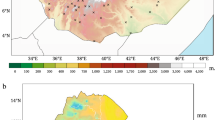Abstract
Precise leveling, tide-gauge recordings and time series from continuous GPS stations are all sources of information about the ongoing postglacial land uplift in Fennoscandia. This article describes how to gather these three sources of data together in a least-squares collocation adjustment in order to calculate uplift rates, as well as new heights for the benchmarks in the leveling network. The estimated reliability of the resulting uplift model is in general better than 0.4 mm/year, decreasing in areas of fewer data.
Similar content being viewed by others
References
Caspary WF (1988) Concepts of network and deformation analysis. Monograph 11, School of Surveying, University of New South Wales, Sydney
Danielsen J (1999) Determination of land uplift in areas not covered by repeated leveling. Licentiate thesis. Report no. 1052. Division of Geodesy. Royal Institute of Technology, Stockholm
Danielsen J (2001) A land uplift map of Fennoscandia. Surv Rev 36(282): 282–291
Ekman M (1988) The world’s longest continued series of sea level observations. Pure Appl Geophys 127:73–77
Ekman M (1996) A consistent map of the postglacial uplift of Fennoscandia. Terra Nova 8:158–165
Ekman M, Mäkinen J (1996) Recent postglacial rebound, gravity change and mantle flow in Fennoscandia. Geophys J Int 126:229–234
King RW, Bock Y (1999) Documentation for the GAMIT GPS analysis software. Massachusetts Institute of Technology, Massachusetts, http://www-gpsg.mit.edu/~simon/gtgk/
Lidberg M (2004) Motions in the geodetic reference frame. Licentiate thesis, Chalmers University of Technology, Onsala
Lambeck K, Smither C, Ekman M (1998): Tests of glacial rebound models for Fennoscandinavia based on instrumented sea- and lake-level records. Geophys J Int 135:375–387
Pelzer H (1985) Geodätische Netze in Landes- und Ingenieurvermessung II. Chapter 2: Überfürung von Ausgleichungsmodellen
Schwarz KP (1976) Least squares collocation for large systems. Bollettino di Geodesia e Scienze Affini 35(3):309–324
Williams SDP (2003) The effect of coloured noise on the uncertainties of rates estimated from geodetic time series. J Geod 76(9–10):483–494 DOI 10.1007/s00190–002–0283-4
Author information
Authors and Affiliations
Corresponding author
Additional information
A smoother and extended version of the land uplift model described here is used in the adjustment of the new height system in Sweden (RH 2000) under the name RH 2000 LU. Later on, the name was changed to NKG2005LU. The Finnish Geodetic Institute (FGI) has decided to use the same model when they calculate their new height system, N2000.
Rights and permissions
About this article
Cite this article
Vestøl, O. Determination of Postglacial Land Uplift in Fennoscandia from Leveling, Tide-gauges and Continuous GPS Stations using Least Squares Collocation. J Geodesy 80, 248–258 (2006). https://doi.org/10.1007/s00190-006-0063-7
Received:
Accepted:
Published:
Issue Date:
DOI: https://doi.org/10.1007/s00190-006-0063-7




